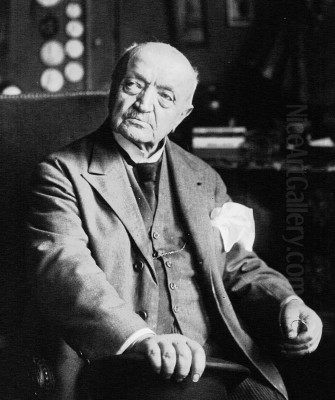
Giovanni Boldini stands as one of the most distinctive and sought-after portrait painters of the late 19th and early 20th centuries. An Italian by birth who found fame in the vibrant art capitals of London and, most significantly, Paris, Boldini developed a signature style that perfectly encapsulated the energy, elegance, and underlying nervousness of the Belle Époque. His canvases, alive with dynamic brushwork and a keen eye for fashion and personality, immortalized the elite of his time, leaving behind a dazzling visual record of a bygone era. Known affectionately and sometimes critically as the "Master of Swish," his work continues to fascinate audiences with its technical brilliance and its evocative portrayal of high society.
Ferrara Roots and Florentine Formation
Giovanni Boldini was born in Ferrara, Italy, on December 31, 1842. Artistry was in his blood; his father, Antonio Boldini, was a painter primarily focused on religious subjects, as well as a skilled art restorer and copyist. His mother was Benvenuta Calvi. This familial environment provided the young Giovanni with his initial exposure to the techniques and traditions of painting. He absorbed the fundamentals under his father's tutelage, showing remarkable talent from an early age.
Seeking formal training and broader artistic horizons, Boldini moved to Florence in 1862, enrolling at the Academy of Fine Arts. There, he studied under masters such as Stefano Ussi and Enrico Pollastrini. Florence at this time was a crucible of artistic innovation, particularly through the influence of the Macchiaioli group. Boldini frequented the Caffè Michelangiolo, a famous meeting place for these artists, and formed connections with key figures of the movement.

The Macchiaioli, including painters like Giovanni Fattori, Silvestro Lega, Telemaco Signorini, Vito D'Ancona, and Cristiano Banti, were reacting against the staid academicism of the time. They advocated for painting outdoors (plein air) and used patches or "macchie" of color and chiaroscuro to capture the immediate effects of light and shadow. Though Boldini never fully adopted their style, their emphasis on realism, direct observation, and capturing fleeting moments undoubtedly left an impression on his developing artistic sensibility, particularly visible in his early landscapes and portraits. His association with Michele Gordigiani, another Florentine portraitist, also proved influential during this period.
London Calling and the Parisian Ascent
Before settling permanently in Paris, Boldini spent time in London, where his talent for portraiture quickly gained recognition. He achieved considerable success, painting members of the English aristocracy and society figures. This period helped establish his reputation internationally and honed his skills in navigating the world of wealthy patrons, a skill that would prove invaluable in Paris. The London experience likely refined his understanding of the specific demands of society portraiture – the need to flatter while still capturing a likeness and conveying status.
However, the true center of the art world beckoned. In 1872, Boldini made the decisive move to Paris. This city, buzzing with artistic experimentation and social dynamism, would become his home and the primary stage for his long and prolific career. Paris offered a stimulating environment where traditional salons coexisted with avant-garde movements, and where social ambition and artistic innovation fueled each other. Boldini arrived ready to make his mark.
He established a studio and quickly immersed himself in the city's cultural life. His Italian charm, combined with his undeniable talent, opened doors to influential circles. Paris provided not only patrons but also crucial artistic connections that would shape the evolution of his unique style. He began exhibiting regularly at the Paris Salon and other prestigious venues, rapidly building a clientele among the French and international elite residing in the capital.
Parisian Circles: Friendships and Artistic Dialogue
Boldini's arrival in Paris coincided with the height of Impressionism, and he soon found himself interacting with key figures of the movement. Most notably, he formed a lasting friendship with Edgar Degas. Both artists shared an interest in capturing modern life, movement, and the psychological nuances of their subjects, although their stylistic approaches differed significantly. Degas's innovative compositions and focus on capturing figures in motion likely resonated with Boldini's own developing dynamism.
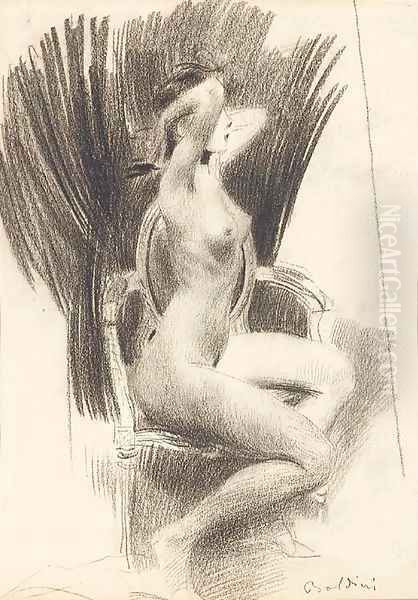
While influenced by the Impressionists' brighter palettes and looser brushwork, Boldini never fully subscribed to their core tenets. His work retained a stronger connection to academic draftsmanship, particularly in the rendering of faces and hands, even as the surrounding elements dissolved into energetic strokes. His style found closer parallels with other highly successful society portraitists of the era, particularly the American expatriate John Singer Sargent and the French artist Paul Helleu.
Boldini, Sargent, and Helleu formed a triumvirate of sorts, dominating the lucrative market for society portraits in Paris and London. They shared a dazzling technical facility, an ability to convey glamour and status, and a knack for capturing the fashionable silhouettes of the time. They were friends and sometimes friendly rivals, their works often exhibited together, inviting comparisons. Boldini's style, however, remained distinct, often characterized by a greater sense of nervous energy and flamboyant movement compared to Sargent's more solid, albeit equally brilliant, brushwork, or Helleu's elegant drypoints and pastels. He also maintained connections with figures like James McNeill Whistler, another expatriate artist known for his elegant portraits and aesthetic sensibilities.
The Boldini Style: "Master of Swish"
Boldini's mature style is instantly recognizable and earned him the moniker "Master of Swish." It is characterized by exceptionally fluid, elongated brushstrokes that seem to whip across the canvas, imbuing his figures with a sense of restless energy and perpetual motion. This technique was particularly effective in rendering the luxurious fabrics, feathers, and furs favored by his wealthy clientele, making the textures almost palpable and suggesting the rustle of silk or the softness of velvet.
His compositions often feature figures placed dynamically within the frame, sometimes cropped unconventionally, adding to the sense of immediacy. He frequently employed a low viewpoint, making his sitters appear taller and more imposing. A signature element is the contrast between the meticulously rendered face and hands – capturing a precise likeness and psychological intensity – and the almost abstract, vortex-like treatment of the clothing and background. This contrast focuses the viewer's attention on the sitter's personality while simultaneously conveying the whirlwind of their social lives.

Boldini possessed an extraordinary ability to capture not just a likeness, but the attitude of his sitters – their confidence, hauteur, allure, or nervous energy. His female portraits, in particular, often feature elongated necks and torsos, impossibly small waists, and dramatic poses that emphasize elegance and fashionable ideals. The rapid, seemingly effortless brushwork suggests a fleeting moment captured, perfectly mirroring the fast-paced, ephemeral nature of high society life during the Belle Époque. His palette could range from subtle harmonies of grey and black, influenced perhaps by Whistler, to vibrant bursts of color, especially in rendering flowers or sashes.
Chronicler of the Belle Époque: Subjects and Sitters
Boldini became the painter par excellence of the Belle Époque elite. His studio was a magnet for aristocrats, artists, writers, musicians, actresses, and courtesans – anyone who mattered in the glittering social world of Paris, London, and beyond. To be painted by Boldini was a mark of status, a confirmation of one's place in the upper echelons of society. His sitters represented the wealth, power, and cultural influence of the era.
Among his most famous and recurring subjects was the Marchesa Luisa Casati. An eccentric Italian heiress and muse, Casati commissioned numerous portraits from Boldini, each capturing a different facet of her flamboyant personality. The portraits of Casati, often depicted with her greyhounds or in dramatic costumes, are iconic representations of decadent aristocracy and female self-fashioning at the turn of the century.
Another celebrated portrait, discovered decades after the artist's death in a Parisian apartment untouched for 70 years, is that of the actress Marthe de Florian. The painting, found alongside love letters from Boldini, caused a sensation and added a layer of romantic intrigue to his biography. He also painted the elegant Princess Marthe Bibesco, the American socialite Rita Lydig, and the Sicilian aristocrat Franca Florio, whose portrait captured the epitome of Mediterranean grace and nobility.
His male sitters were equally distinguished. He painted the renowned Italian composer Giuseppe Verdi in his final years, capturing the maestro's venerable dignity. A particularly striking portrait is that of Count Robert de Montesquiou, the quintessential dandy, writer, and aesthete who served as a model for characters in novels by Joris-Karl Huysmans and Marcel Proust. Boldini's depiction perfectly captures Montesquiou's aristocratic hauteur and refined sensibility. He also painted political figures like French President Félix Faure and even the exiled Empress Eugénie.
Through these portraits, Boldini did more than just record likenesses; he captured the spirit of an age – its opulence, its sophistication, its theatricality, and perhaps its underlying anxieties as the 19th century gave way to the 20th.
Exploring Key Works
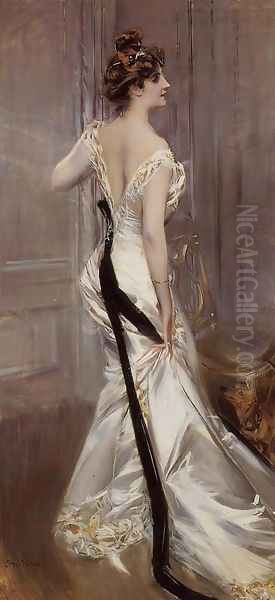
Beyond the famous portraits, several works highlight different facets of Boldini's artistry. The Portrait of Marchesa Luisa Casati with a Greyhound (c. 1908) is perhaps his most emblematic work, showcasing the "swish" style at its peak. The Marchesa strides forward, a whirlwind of grey and black fabric, her intense gaze fixed on the viewer, the sleek form of the greyhound echoing her own elongated elegance. It's a portrait of power, eccentricity, and restless energy.
The Portrait of Marthe de Florian (c. 1888/1898) reveals a slightly softer, more intimate side, though still infused with Boldini's characteristic bravura. The sitter reclines alluringly on a sofa, draped in a pink peignoir, her expression both inviting and enigmatic. The discovery story adds layers of narrative, making it one of his most talked-about works today.
His Portrait of Giuseppe Verdi (1886) is a more sober and psychologically penetrating work. Painted in pastels, it captures the aged composer with quiet dignity and introspection, the focus entirely on the face and expression, rendered with remarkable sensitivity. It demonstrates Boldini's versatility beyond flamboyant society portraits.
Works like The Dispatch Bearer and Firework (La Scintilla) show his skill in genre scenes, often featuring historical or anecdotal subjects, executed with the same lively brushwork and attention to detail seen in his portraits. His Female Nude paintings demonstrate his mastery of the human form, often rendered with a sensuality and immediacy that borders on the provocative, showcasing his academic training fused with modern sensibility.
Boldini also produced numerous landscapes and cityscapes, particularly views of Venice and Paris. These works, often smaller in scale, allowed him to experiment more freely with Impressionistic effects of light and atmosphere, capturing the bustling energy of Parisian streets or the shimmering reflections on Venetian canals with quick, suggestive strokes. They provide a counterpoint to his formal portraiture, revealing his broader artistic interests.
Recognition, Rewards, and Ripples of Criticism
Boldini enjoyed immense success during his lifetime. His paintings were highly sought after, commanded high prices, and were regularly featured in the prestigious Paris Salons and international exhibitions. He achieved official recognition as well; in 1889, he was appointed commissioner for the Italian section of the Paris Exposition Universelle and was awarded the Légion d'honneur by the French government, a significant mark of distinction. His exhibition in New York in 1897 was met with great acclaim, solidifying his transatlantic reputation.
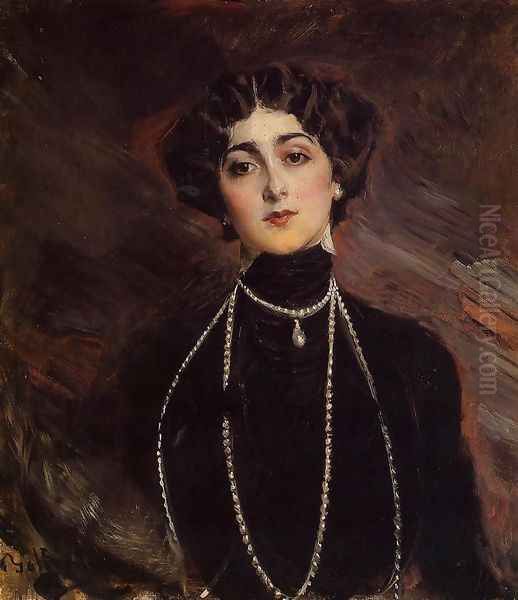
Despite his popularity and critical success, Boldini's work was not without its detractors. Some critics, particularly those championing the more radical avant-garde movements, dismissed his art as superficial, overly virtuosic, and catering primarily to the vanity of his wealthy sitters. They argued that his focus on elegance and fashion lacked deeper substance or social commentary. His style was sometimes seen as repetitive or formulaic, prioritizing dazzling effect over profound insight.
While there may be some truth to these criticisms – Boldini was undeniably a commercial success who understood his market – they overlook the genuine artistic merit and historical significance of his work. His technical skill was extraordinary, and his ability to capture the specific aura of the Belle Époque remains unparalleled. He possessed a keen psychological insight, often revealing subtle aspects of his sitters' personalities beneath the glamorous facade. Furthermore, his dynamic style was innovative in its own right, pushing the boundaries of traditional portraiture.
Later Years and Enduring Legacy
Boldini continued to paint actively well into the 20th century, adapting his style slightly but remaining largely true to the aesthetic he had perfected. He witnessed the dramatic shifts in art brought by Fauvism, Cubism, and other modern movements, but he remained essentially a brilliant exponent of late 19th-century sensibilities, albeit one whose energy foreshadowed modernist dynamism. He remained a sought-after portraitist until late in his life.
Giovanni Boldini died in Paris on January 11, 1931, at the age of 88. He left behind a vast body of work that continues to captivate viewers. His paintings are held in major museum collections around the world, including the Musée d'Orsay in Paris, the Metropolitan Museum of Art in New York, the National Portrait Gallery in London, the Uffizi Gallery and Pitti Palace in Florence, and, fittingly, the Museo Giovanni Boldini in his hometown of Ferrara.
His legacy extends beyond the realm of fine art. Boldini's emphasis on fashion, elegance, and dynamic lines had a noticeable influence on fashion illustration and graphic design in the early 20th century. More importantly, he remains a key visual chronicler of the Belle Époque, an era of immense social change, technological advancement, and cultural ferment. His portraits offer a unique window into the lives, aspirations, and aesthetics of the elite who defined that glittering, complex period.
Conclusion: The Enduring Appeal of Boldini
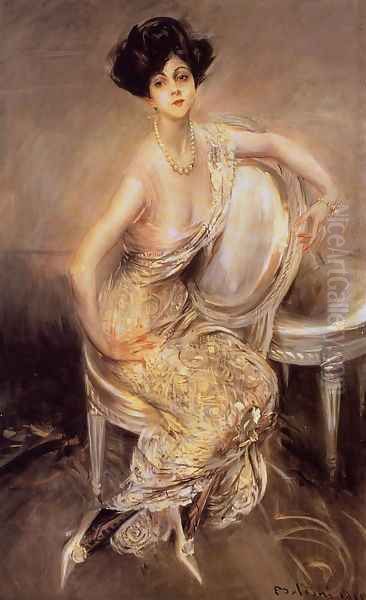
Giovanni Boldini carved a unique niche for himself in the bustling art world of the late 19th and early 20th centuries. Bridging Italian tradition, Florentine realism, and Parisian modernity, he developed a style that was entirely his own – energetic, elegant, and undeniably captivating. As the "Master of Swish," he not only painted the faces of the Belle Époque but captured its very essence: its glamour, its velocity, its luxury, and its fleeting nature. While sometimes criticized for superficiality, his work possesses a technical brilliance and a psychological acuity that transcends mere flattery. Today, Boldini's paintings remain potent symbols of a lost world, continuing to fascinate with their dazzling technique and their vibrant portrayal of an era defined by both opulence and change.